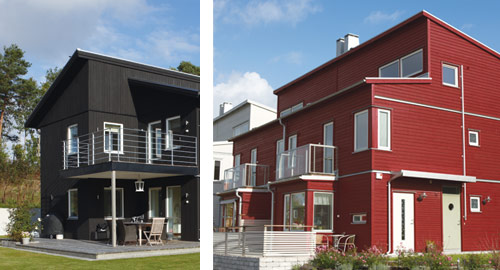Auson pigmented Pine Tar is a true product of nature. The Pine Tar provides the facade with a classic, matte color and there is long time until next treatment is needed. It is perfectly fine to paint on wooden facades previously treated with traditional paint. The Pine Tar penetrates deep into the wood and effectively adds the natural substances the wood itself uses as a protection against microorganism.

Preserve with Auson Pigmented Pine Tar
Auson pigmented Pine Tar comes in four different colors; Red, Black, Yellow and Brown. The Pine Tar is of highest quality and the pigment is a natural additive. The Pine Tar is especially suitable for facades and wooden constructions out doors, simply where you wish the combination of the Pine Tar preservative features and a stylish color.

PAINTING WITH PINE TAR
Painting with pine tar is a different experience compared to regular and modern paint. The pine tar is based on substances produced naturally in the woods and is prepared by dry distillation of wood, especially pine. Depending on the species of pine used in the preparation, the pine tar may have a different odor and color.
Before painting:
Our pigmented pine tars need to be diluted with about 20% gum turpentine or warm up to 50-60 ° C before painting. Our Bright tar oil and our Pine tar vitriol are ready for use after stirring.
Make sure the timber is dry before you start to paint, that will enable the pine tar to penetrate the wood. If the wood contains too much moisture, the tar will settle on the surface instead. .
We recommend painting during hot weather, at least 10°C. Then the pine tar is more convenient to work with.
The Pine Tar can be painted directly on untreated wood without primer or on earlier tarred or mud colored wood. You could also paint Pine Tar Vitriol over Iron vitriol.
Wood tar is a natural product which can vary in appearance from different productions. If you have several cans, mix the estimated amount needed for the surface to avoid any color differences.
When painting:
As the tar is sucked into the timber, we recommend to use a wide brush (70-100 mm) to avoid an uneven surface.
Stir the can any now and then during painting to mix up the pigment.
For the best water protection, we recommend two coats. It is ok to delay the second coating up to a year as the first coat will protect the wood during this time.
After painting:
The drying time is ca 24 h at normal outdoor temperatures during grinding season. For new construction, it may be helpful to paint wood on the ground for maximum coverage.
The wonderful Pine Tar odor is present for about a month after the painting. However, the smell decreases considerably only after a few days.
We recommend painting every 5-10 years. The large range depends on the climate but also on the quality of the wood. Once it is time to paint again, simply remove dirt from the facade and then you are ready to apply a new layer of Pine Tar.
CLASSIC WOOD PROTECTION

For many centuries, wood tar was used in the Nordic countries to protect and preserve house facades and wooden structures. We know that the Vikings treated their ships with
wood tar to protect the wood against rot and many medieval buildings are still standing – those that were treated regularly with wood tar.
Auson and the East Indiaman
Auson is a proud supporter of the East Indiaman Götheborg. Thanks to Auson Genuine Wood Tar, the stately ship’s wooden features can be maintained and preserved with high-quality traditional wood protection. In 1743 the East Indiaman made its last journey when the ship set sail for a trading voyage to China. 30 months later, with Gothenburg harbor in sight, the ship ran aground. After the final salvaging operation in 1984, the tremendous idea of creating a reconstruction of the ship using the original methods started to take form, to once again set sail for China.
Wood tar as an export product
During the 17th century, Sweden and Finland had a unique position in the world as the sole exporters of wood tar. During the 1680s, approximately 16 million litres of tar per year were produced annually in Sweden. The manufacture of wood tar was an important source of extra income for Swedish and Finnish smallholders during this period.
Different areas of use
Traditionally, wood tar had many more applications than the preservation of wood. In ancient times wood tar was used as a medicine for chest illnesses. In the Nordic countries, it was mainly used in the form of tar water, which was considered to be a first-class medicine. Raw black pine tar was used as a universal cure and was added to butter, spirits, and ointments for skin complaints and chronic eczema. Tar soap was commonplace and can still be found in shops with elderly clientele.
Wood tar in a modern form
Today, many centuries later, wood tar continues to provide good protection for the wood. At Auson we have utilized wood tar’s unique protective properties at the same time as we have added modern pigments, taking wood tar into the 21st century. Wood tar is not just a wood preservative; with its mild antiseptic properties, it is used in a variety of pharmaceutical and veterinary products.


